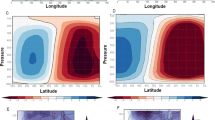Abstract
An attempt to diagnose the dominant forcings which drive the large-scale vertical velocities over the monsoon region has been made by computing the forcings like diabatic heating fields,etc. and the large-scale vertical velocities driven by these forcings for the contrasting periods of active and break monsoon situations; in order to understand the rainfall variability associated with them. Computation of diabatic heating fields show us that among different components of diabatic heating it is the convective heating that dominates at mid-tropospheric levels during an active monsoon period; whereas it is the sensible heating at the surface that is important during a break period. From vertical velocity calculations we infer that the prime differences in the large-scale vertical velocities seen throughout the depth of the atmosphere are due to the differences in the orders of convective heating; the maximum rate of latent heating being more than 10 degrees Kelvin per day during an active monsoon period; whereas during a break monsoon period it is of the order of 2 degrees Kelvin per day at mid-tropospheric levels. At low levels of the atmosphere, computations show that there is large-scale ascent occurring over a large spatial region, driven only by the dynamic forcing associated with vorticity and temperature advection during an active monsoon period. However, during a break monsoon period such large-scale spatial organization in rising motion is not seen. It is speculated that these differences in the low-level large-scale ascent might be causing differences in convective heating because the weaker the low level ascent, the lesser the convective instability which produces deep cumulus clouds and hence lesser the associated latent heat release. The forcings due to other components of diabatic heating, namely, the sensible heating and long wave radiative cooling do not influence the large-scale vertical velocities significantly.
Similar content being viewed by others
References
Awade, S. T. andKeshavamurthy, R. N. (1975),Vertical motion in the Indian Summer monsoon. Indian J. Met. Hydrol. Geophys.26 (3), 384–390.
Das, P. K. (1962),Mean vertical motion and nonadiabatic heat sources over India during the monsoon. Tellus,XIV (2), 213–220.
Danard (1969),A simple method of including long-wave radiation in a tropospheric numerical prediction model. Monthly Weather Review97, (1), 77–85.
Goswami, B. N. (1987),The sensitivity of the northern hemisphere summer mean meridional circulation to changes in large-scale eddy forcing. Proceedings of Indian Academy of Sciences, Earth and Planetary Sciences94, 123, November 1985, pp. 219–235.
Holten, James R. (1979),An introduction to dynamic meteorology. International Geophys. Series (Academic Press, Inc., 111 Fifth Avenue, NY 100003).
Kusuma, G. Rao (1985),On the mean-meridional circulation during the contrasting periods of normal and below normal monsoon activity. Mausam36, 13–20.
Kusuma, G. Rao (1986),Sensible heat fluxes during the active and break phases of the southwest monsoon over the Indian region. Boundary Layer Meteorology36, 283–294.
Pant, P. S. (1983),A physical basis for changes in the phases of the summer monsoon over India. Monthly Weather Review111, 487–495.
Rao Sankar, M. andSachidananda, S. V. (1987),On global summer monsoonal drought mechanics. Proceedings of Indian Academy of Sciences, Earth and Planetary Sciences96, 2, 147–167.
Saltzmann, andAshe, (1976),Parameterization of the monthly mean vertical heat transfer at the earth's surface. TellusXXVIII (4), 601–620.
Saha, K. (1968),On the instantaneous distribution of vertical velocity in the monsoon field and structure of the monsoon circulation. TellusXX (4), 601–620.
Singh, U. S., Singh, B. P. andRathor, H. S. (1974),Vertical velocity due to mean-baroclinicity and diabatic heating of the atmosphere. PAGEOPH112.
Webster, Peter, J.,Monsoons (Eds. Jay S. Fein and Pamela L. Stephens) (Wiley-Interscience Publication, John Wiley and Sons, 1987).
Author information
Authors and Affiliations
Rights and permissions
About this article
Cite this article
Rao, K.G. Diagnosis of dominant forcing factors for large-scale vertical velocities during active and break phases of the monsoon. PAGEOPH 127, 669–693 (1988). https://doi.org/10.1007/BF00881751
Revised:
Accepted:
Issue Date:
DOI: https://doi.org/10.1007/BF00881751




